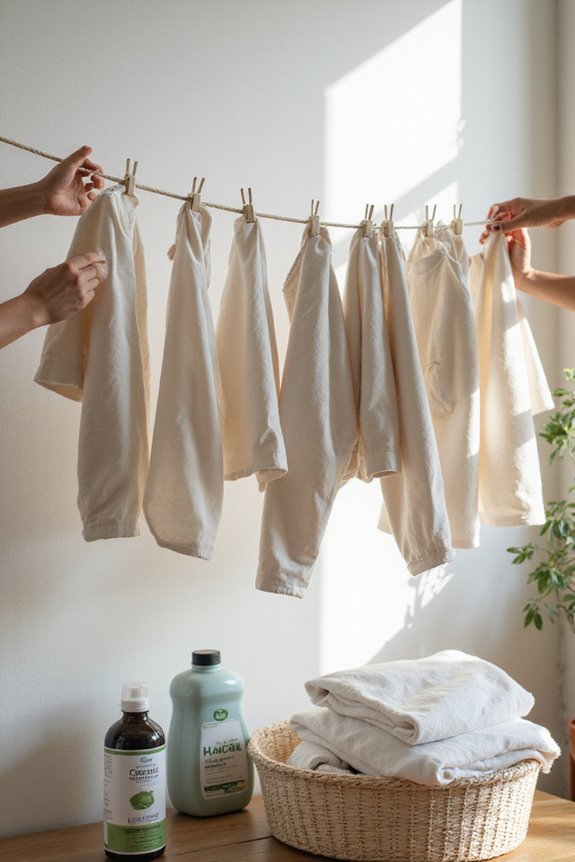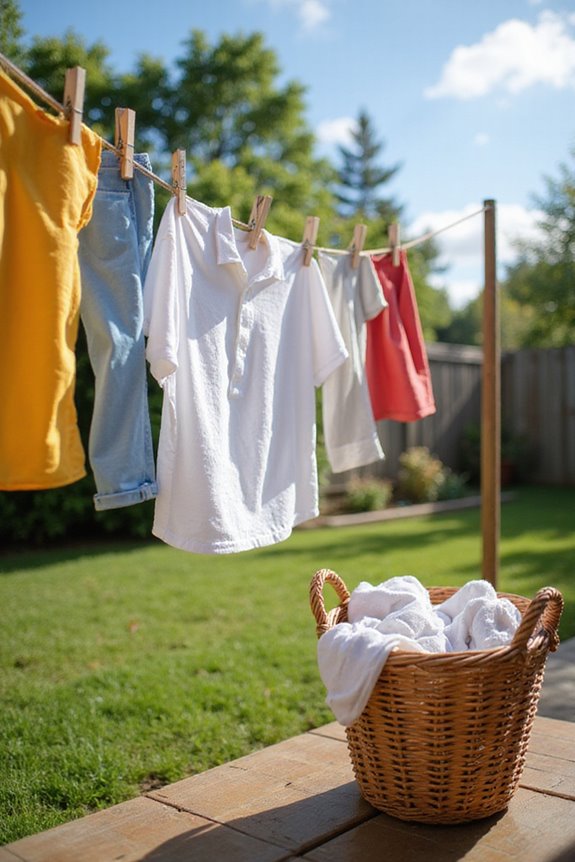When we line dry clothes, it’s key to start with a clean clothesline and check if it’s taut. We should hang pants by the cuffs and shirts upside down to avoid pesky creases. Sorting fabrics helps too—keep delicates separate from heavier items. Don’t overcrowd the line; airflow helps drying and reduces wrinkles. Let’s remember to use clothespins properly, so our clothes don’t blow away. Stick around, and we’ll uncover more handy tips for fresh laundry!
Key Takeaways
- Ensure the clothesline is clean and taut for effective hanging and drying.
- Sort fabrics by type and color to prevent damage and color bleeding.
- Use wooden clothespins on hems instead of the middle to avoid stretching and puckering.
- Space out garments on the line to enhance airflow and reduce wrinkles.
- Shake out clothes before hanging to minimize creases and improve drying efficiency.
Preparation Before Line Drying
Before we immerse ourselves in the art of line drying, let’s take a moment to prepare ourselves and our laundry. First, we need to guarantee our clothesline is clean—no dirt or bird droppings here! A quick wash and rinse will do wonders. Let’s also check the tautness; a secure line keeps our clothes off the ground.
Now, let’s talk pin selection. Wooden clothespins are our best bet. They’re gentle on fabrics and won’t cause snags. Make sure to wipe them down too; hygiene matters!
Finally, let’s avoid overpacking the washing machine. This helps reduce crinkles and makes our line drying experience smoother. With these simple steps, we’re ready to hang our laundry with confidence!
Proper Hanging Techniques

Now that we’ve prepped our laundry for line drying, it’s time to get into the nitty-gritty of how to hang our clothes properly. First, let’s talk hanging methods. For pants, we should hang them by the cuffs or legs to let the waistband pull out wrinkles naturally. Shirts? They’re best hung upside down at the hemline—this avoids those pesky clothespin puckers.
When it comes to clothespin placement, we want to avoid pinning in the middle. Instead, let’s pin hems and edges to prevent stretching. For heavier items, like sheets, we can fold them in half and use multiple pins. And remember, turning pockets out on shorts helps speed up drying. Happy hanging!
Sorting and Managing Loads

When it comes to sorting and managing our laundry loads, we’ve got a few key strategies to keep in mind. First, let’s talk about sorting fabrics. By grouping similar materials, like cotton with cotton, we can prevent damage during line drying. Delicates should hang separately from heavier items, like denim, to avoid fabric strain. Now, on to color management: separating darks, lights, and whites helps prevent color bleeding. Newly dyed items? They definitely need their own space! When loading the line, let’s not overcrowd it. This guarantees airflow, speeding up drying time. Finally, shaking out garments before hanging helps reduce wrinkles. With these tips, we can make laundry day smoother and maybe even a bit more fun!
Environmental Considerations

As we immerse ourselves in the environmental considerations of line drying clothes, it’s clear that this simple practice can have a big impact on our planet. By choosing to line dry, we cut down on energy use and reduce carbon emissions. Clothes dryers account for about 3% of U.S. residential energy use, contributing massive CO₂ emissions. In contrast, line drying produces zero emissions!
We can also adapt our drying techniques based on weather impacts. A sunny day can speed up the process, while a breezy afternoon can help our clothes smell fresh. Even partial line drying can lower greenhouse gas emissions by up to 67%. So, let’s embrace the outdoors and do our part for the environment!
Fabric Care and Longevity

Line drying clothes not only benefits the environment but also plays a big role in keeping our fabrics looking great for longer. By avoiding the heat and tumbling of dryers, we help maintain fiber durability and garment preservation. This gentler method reduces the risk of fiber tearing and prevents shrinkage, ensuring our favorite shirts and pants keep their original shape. Plus, air drying helps retain vibrant colors, unlike that sneaky dryer heat that fades our clothes over time. We’ve all seen how quickly a favorite sweater can lose its charm in a dryer! So, let’s embrace line drying and enjoy longer-lasting wardrobe staples. Our clothes will thank us—and so will our wallets! Additionally, using rust-resistant materials in clotheslines can enhance the durability and efficiency of the drying process, making it a more sustainable choice.
Efficiency and Practical Tips
Getting the most out of our line drying experience can be a game-changer in our laundry routine. We can save money and energy by embracing line drying benefits. Using a large rotary line dryer, we can hang up to three full loads at once, speeding up our laundry process. It’s great to wash while the clothes are drying, so we avoid those lengthy dryer cycles. Plus, investing in quality drying equipment, like retractable clotheslines, can save space and stand the test of time. We might even find ourselves saving over $60 a year on energy costs! Additionally, utilizing durable materials in our drying solutions ensures longevity and reliability. So, let’s mix line drying with occasional machine use to make our laundry efficient and eco-friendly. Happy drying!
Common Mistakes to Avoid
While we’ve explored ways to make our line drying more efficient, it’s equally important to recognize what not to do. One common mistake is skipping clothes pegs. Without them, our garments are at risk of blowing away or getting soiled. Using a single peg for multiple items can reduce airflow, decreasing drying efficiency. We should also avoid bunching clothes together; it hinders air circulation and causes wrinkles. Incorrect hanging techniques, like folding clothes over the line, can leave us with crease marks. Additionally, overloading the washer means our clothes might not dry properly. Let’s not forget to sort our laundry by weight and color. Keeping these mistakes in mind will help us achieve the best results when line drying. Incorporating a space-saving solution like a collapsible drying rack can also enhance the efficiency of your drying process.
Frequently Asked Questions
Can I Use Fabric Softener When Line Drying Clothes?
While fabric softener can seem tempting, we should consider its impact. Instead, let’s explore fabric softener alternatives that preserve line drying benefits, keeping our clothes fresh and soft naturally without the buildup or chemicals.
How Do I Prevent Clothes From Blowing Away While Drying?
To prevent clothes from blowing away while drying, we can use wind resistant techniques. Securing clothes with pegs and hangers, and choosing sheltered spots, helps keep our laundry stable and safe from gusts.
Is It Safe to Line Dry Clothes Indoors?
As we hang our clothes like fluttering flags indoors, we must remember that increased indoor humidity can spark mold concerns. It’s wise to guarantee good ventilation to keep our living spaces healthy and fresh.
How Often Should I Clean My Drying Line or Rack?
When considering drying line maintenance, we recommend cleaning every six months to a year, depending on usage and environment. Frequent inspections help determine cleaning frequency, ensuring our drying lines remain hygienic and effective.
Can I Line Dry Clothes Year-Round in Different Climates?
As the seasons dance around us, we can indeed line dry clothes year-round. With climate considerations and seasonal adjustments, we find ways to embrace the sun, wind, and even frost for fresh, air-dried laundry.






